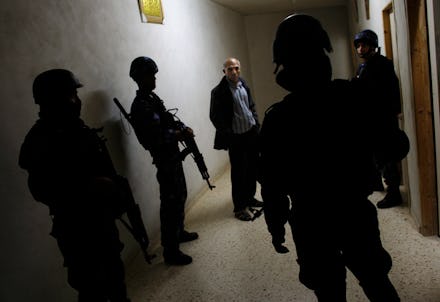An Inside Look At the Israeli Spy Agency's Secret Kill List

Last Tuesday, a Hezbollah leader named Hussein Al-Laqis was shot in the head at close range outside of Beirut, Lebanon, raising questions as to Israel’s role in the targeted killing.
Al-Laqis was a weapons-manufacturing expert who procured arms, computers, cameras, drones, and other high-tech gear for the militant Shi’a group, and according to Foreign Policy, he was part of an elite class of Hezbollah fighters with “advanced operational, organizational, and technological capabilities.”
While Israel has denied involvement in the assassination, Al-Laqis fits the profile of several other high-ranking operatives who have been picked off over the years, as investigative reporter Ronen Bergman, the author of The Secret War With Iran, points out.
Here, then, is a comparison between Al-Laqis and several of his fellow fallen associates, which may constitute an unofficial hit list by Mossad, Israel's formidable intelligence agency.
1. Imad Mughniyeh
Before he was killed by a car bomb in Damascus, Syria, in February 2008, Imad Mighniyeh was Hezbollah's top ranking military commander, had a hand in some of the group's most notorious acts of violence, and was on the United States' list of Most Wanted Terrorists. Mighniyeh was implicated in the deadly 1983 United States embassy and barracks bombings in Beiruit; the hijacking of TWA 847; the kidnapping, torture, and murder of Western hostages, including a CIA station chief; the bombing of the Israeli embassy in Buenos Aires, Argentina; and the 1996 Khobar Towers bombing in Saudi Arabia. He was also involved in the kidnapping of Israeli soldiers that precipitated the 2006 conflict between Lebanon and Israel. While Israel officially denies assassinating Mughniyeh, the country is widely suspected of it.
2. Muhammad Suleiman
Muhammad Suleiman was a high-ranking general in the Syrian Army, and from the mid-90s until his death, he was Bashar al-Assad's go-to for everything from weapons procurement, to exporting arms to Hezbollah, to the development of what may have been a nuclear facility. In 2008, Suleiman was shot on the beach while vacationing at his chalet. While Israel is suspected of the killing, it could also have been the result of internecine Syrian squabbling, according to a French cable revealed by Wikileaks.
3. Hassan Tehrani Moghaddam
A general in the Islamic Revolutionary Guards Corps, Hassan Tehrani Moghaddam helmed Iran's missile program from 1983 onward, and refined the country's long-range ballistics capabilities. He was killed in a November 2011 explosion that could be felt 30 miles away, and which falls into a pattern of bombings and shootings of Iranian scientists involved with the country's nuclear program.
4. Mahmoud Al-Mabhouh
Mahmoud Al-Mabhouh was a senior military commander of Hamas who was responsible for procuring weapons and maintaining ties with Iran, and may have been behind the 1989 kidnapping and murder of two Israeli soldiers. In 2010, Al-Mabhouh was drugged and suffocated in a luxury hotel room in Dubai, leading to an international scandal, as it came to light that several dozen Mossad agents had traveled to the United Arab Emirates using fake European passports, ostensibly in order to monitor and kill Al-Mabhouh.
5. Hussein Al-Laqis
Which brings us back to last week's targeted killing of Al-Laqis. While several unknown groups attempted to claim responsibility for the assassination on Twitter, Hezbollah was quick to blame Israel for the killing, and Israel was equally quick to deny any involvement. It is possible that another group was responsible; the Washington Post suggests that Syrian rebels, Al-Qaeda linked groups, and even Saudi Arabia could be behind the murder of Al-Laqis. However, it seems equally likely that Al-Laqis' death comes as part of a concerted effort to dismantle the networks responsible for bringing arms into Syria, Lebanon, and Palestine.